Since its inception, the mission of SpaceX has been to make humanity a multi-planetary species by colonizing Mars. Billionaire Elon Musk believes the Starship spacecraft his company has been developing will be able to ferry humans to the red planet. On Sept.30, he held an event at SpaceX’s test facility near Boca Chica in Texas to talk about his plans for the Starship spacecraft.
Multiple prototypes of the Starship spacecraft
Showing off the Starship Mk1 prototype, Elon Musk said it was “the most inspiring thing I’ve ever seen.” If the design and manufacturing keep progressing at the current pace, the Starship will be able to make it to orbit in less than six months.
Musk also talked about the Falcon 1, which was standing next to the Starship prototype at the Boca Chica facility. The Falcon 1 was the first-ever liquid-fueled rocket developed by a private company to reach the orbit in 2008. Elon Musk told fans that in the last 11 years, SpaceX has launched 78 successful missions.
Last month, a Starhopper prototype test vehicle successfully completed low-altitude flights or “hops” with a single Raptor engine. The Starship Mk1 with three Raptor engines will make its first flight to an altitude of 12 miles in the coming weeks. SpaceX is also building a Starship Mk2 in Florida. Construction work on the Mk3 prototype is expected to begin in about a month at Boca Chica, said Musk.
The Mk3 prototype is not going to enter the orbit, even though it will be ready for testing in about three months. The vehicle Musk aims to take to orbit will be the Mk4 or Mk5 prototype, which he hopes would be ready within six months.
It’s worth pointing out that Elon Musk is known for setting extremely ambitious deadlines for his projects. Most of the times, the deadlines get pushed back. So, we wouldn’t be surprised if the Starship spacecraft takes more than six months or a year to achieve the orbit.
During the Sept.28 presentation, Elon Musk also talked about how the Starship spacecraft would control its landing. SpaceX is taking a “new approach” to control a rocket. According to Musk, it will be “akin to a skydiver than a plane.” SpaceX has replaced the carbon fiber heat shield with a steel heat shield, which dramatically reduces the cost.
Starship will use in-space propellant transfer to enable the delivery of over 100t of useful mass to the surface of the Moon or Mars pic.twitter.com/pzCUebidZg
— SpaceX (@SpaceX) September 29, 2019
The Starship spacecraft will use “orbital refilling,” where fuel would be transferred from one spacecraft to another in the orbit. Musk believes orbital refilling would be far easier than docking the spacecraft with the International Space Station.
The Starship will measure 50 meters in length with a diameter of nine meters. It will be capable of carrying payloads of up to 150 tons. Tesla will use its Super Heavy rocket to put the Starship into the orbit.
The Super Heavy rocket would consist of 37 Raptor engines, producing twice as much thrust as NASA’s most powerful rocket Saturn V. The Super Heavy itself will measure 68 meters in length and nine meters in diameter. The number of engines would vary depending on the mission, but the minimum number would be 24 engines.
In the long run, the Starship will not only be able to take humans to the moon or Mars, but also to other planets in our solar system including Saturn, according to Musk.
What about Crew Dragon? Asks NASA
While Musk was talking about the Starship, NASA reminded SpaceX to deliver on the Commercial Crew Program. SpaceX is designing and developing the Crew Dragon spacecraft for NASA, which has seen numerous delays. NASA aims to take humans to the moon once again by 2024.
NASA Administrator Jim Bridenstine said in a statement that the Commercial Crew Program is running years behind schedule. The US space agency wants to see “the same level of enthusiasm focused on the investments of the American taxpayer.” It’s time for SpaceX to deliver on the project.
https://twitter.com/JimBridenstine/status/1177711106300747777
Elon Musk responded by saying that less than 5% of SpaceX employees were dedicated to the Starship project. Most of the company’s resources are on the “Falcon and Dragon, especially Crew Dragon.”





